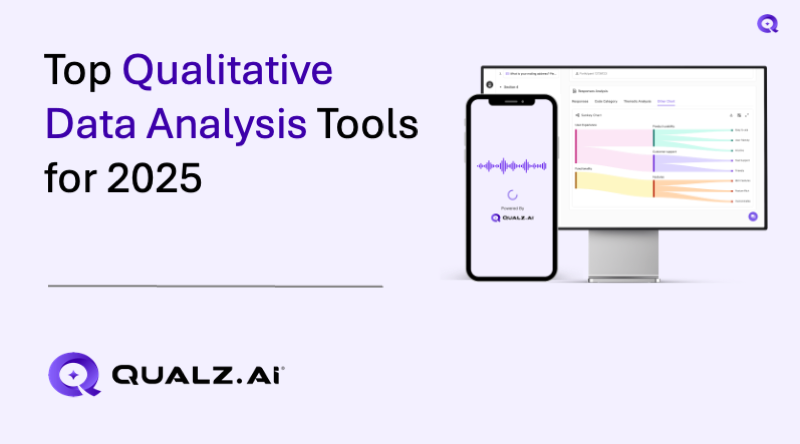Qualitative research is indispensable for uncovering motivations, emotions, and nuanced feedback. But with the rise of unstructured data from interviews, surveys, social media, and open-text responses, manual methods can no longer keep pace.
That’s why qualitative data analysis tools have become essential—not just for organizing and coding text, but for transforming raw input into actionable insights at scale. Whether you’re a market researcher launching product testing or an academic conducting ethnographic studies, the right tool can save weeks of analysis, reduce human error, and surface deeper themes hidden in the data.
Topics Covered
ToggleWhat Makes a Great Qualitative Data Analysis Tool?
The best tools for today’s researchers combine advanced analytics with ease of use. Here’s what to look for:
- Automated Transcription & Open Coding
- Thematic Analysis
- Support for Multiple Data Types (text, audio, video, survey)
- Interactive Dashboards for visual storytelling
- AI-Powered Features for speed and scale
- Collaboration & Custom Reporting
Top 5 Qualitative Data Analysis Tools in 2025
Here are the top tools researchers are using today—ranked by innovation, features, and usability:
NVivo
Best for: Academic researchers and PhD-level analysis
NVivo has long been the gold standard in academic research.
Key Benefits:
- Powerful query functions
- Robust coding tools
- Audio/video/text integration
- Data modeling and framework matrices
Qualz.AI
Best for: Market researchers, academics, independent researchers and NGOs looking for speed, automation, and scalable qualitative insight
Qualz.AI is an AI-powered platform built by researchers for researchers. Unlike legacy tools, it’s designed for end-to-end AI-powered research—from conversation design to deep AI analysis.
Key Features:
- AI-driven surveys, interviews, and real-time voice conversations
- Synthetic participants for instant feedback—no recruitment delays
- Automated transcription, open coding, and thematic analysis
- Interactive dashboards and customizable report generation
- Upload external data (CSV, video, audio, transcripts) for instant analysis
MAXQDA
Best for: Mixed-method researchers and global teams
MAXQDA supports:
- Quant + Qual integration
- Sentiment and frequency analysis
- Multilingual transcription
- Export-ready reports for publication
Atlas.ti
Best for: Researchers working with large, multilingual datasets
Atlas.ti offers:
- Co-occurrence mapping
- Flexible coding schemes
- Multimedia analysis
- Cloud-based team access
Dovetail
Best for: UX and customer insights teams
Dovetail is ideal for agile teams.
Key benefits:
- Interview tagging and quote collection
- Collaboration with designers and product teams
- Highlight reels and shareable insight boards
Not ideal for deep academic-level analysis, but great for fast product feedback loops.
Key Considerations Before Using Qualitative Data Analysis Tools
Before adopting any qualitative analysis software, it’s important to approach it with a thoughtful, research-first mindset. Here are key precautions to keep in mind:
1. Don’t Over-Rely on Automation
AI and automation can speed up coding and theme extraction, but human interpretation remains essential to ensure depth, nuance, and relevance.
2. Uphold Ethical Standards
Ensure the tool you use complies with data privacy laws and ethical research guidelines. This is especially critical for sensitive topics or vulnerable populations.
3. Verify Data Compatibility
Confirm the tool supports the types of data you collect audio, video, transcripts, CSV files, etc. Lack of format support can limit your workflow.
4. Review AI-Generated Results
Even with strong AI models, researchers should review automated themes or code categories to ensure accuracy and contextual relevance.
5. Provide Basic Training for Your Team
While many tools are user-friendly, consistent training helps teams standardize their workflows, interpret outputs correctly, and maximize value from the platform.
Conclusion
Selecting the best qualitative data analysis tool depends on your research goals, budget, and workflow preferences. While all tools aim to support qualitative insight generation, they differ in scope, complexity, automation, and usability.
Ask yourself:
- Do you need deep manual coding or scalable automation?
- Are you working solo or within a collaborative research team?
- Do you prioritize real-time insights, academic rigor, or ease of use?
Each tool in this guide has strengths:
- Some excel in academic rigor (like NVivo, MAXQDA)
- Others focus on accessibility and collaboration
- Newer platforms like Qualz.AI offer automation and AI-powered insights to streamline time-intensive tasks
